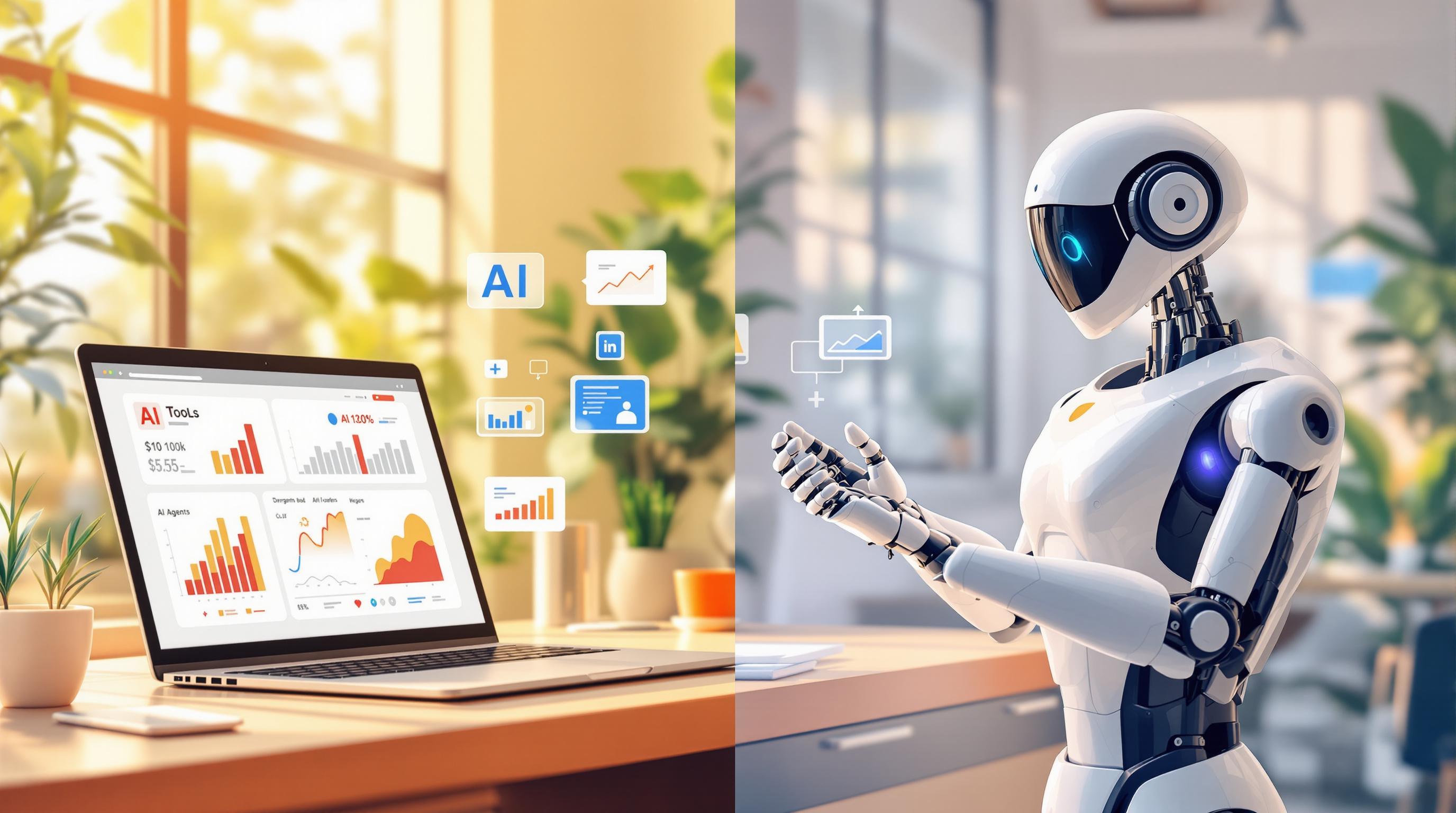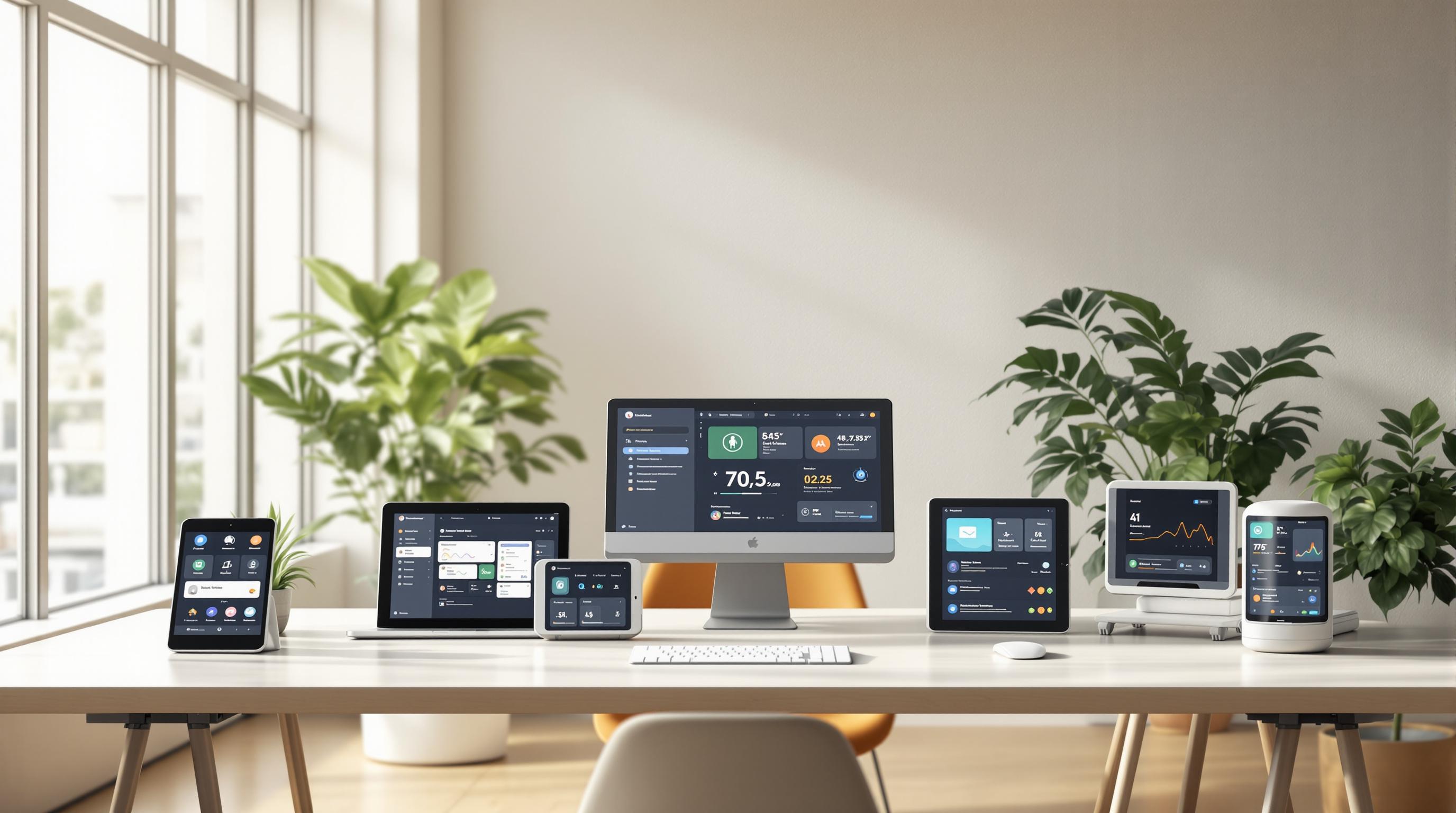AI tools like ChatGPT and MidJourney are reshaping how we work, but they’re not replacing humans. Instead, they’re great at automating repetitive tasks and boosting efficiency, while humans bring creativity, judgment, and oversight. Here’s the key takeaway:
- AI excels at speed and cost-efficiency: ChatGPT generates text 25x faster than humans at $0.002 per 750 words, and MidJourney creates visuals in minutes instead of weeks.
- Humans ensure quality and accuracy: AI struggles with nuanced topics, reasoning, and emotional intelligence. For example, ChatGPT has an 88% accuracy rate for news, compared to humans at 95%.
- Best results come from collaboration: AI handles routine tasks (drafting, coding, data analysis), freeing humans for strategic and creative work.
Quick Comparison
| Tool | Strengths | Limitations | Human Role |
|---|---|---|---|
| ChatGPT | Fast text generation, cost-effective | Accuracy issues, lacks reasoning | Fact-checking, strategic input |
| MidJourney | Quick image creation, cost-saving | Limited creative control | Refining prompts, quality checks |
| AI Apps | Tool discovery, automation | Needs expert evaluation | Strategic tool selection |
AI won’t replace humans - it’s a partner that helps us work smarter, not harder.
Can AI Replace Humans? The Truth About AI and Jobs
1. ChatGPT: Text Generation and Processing

ChatGPT shows strong abilities in generating and processing text, though its performance depends on the specific task. A June 2023 report by McKinsey highlights that generative AI could automate 60% to 70% of employee workloads.
Strengths in Professional Tasks
ChatGPT is particularly effective in several professional areas:
| Task Type | AI Capability | Human Oversight Needed |
|---|---|---|
| Code Generation | Quick routine coding | Logic checks, debugging |
| Content Creation | Writing, summaries, formatting | Fact-checking, creative input |
| Data Analysis | Identifying patterns, basic visuals | Strategic insights |
| Documentation | Creating references, technical writing | Accuracy verification |
Key Limitations
However, ChatGPT has clear limitations that require human intervention. John Schulman, Co-founder of OpenAI, explained:
"Our biggest concern was around factuality, because the model likes to fabricate things".
Some major challenges include:
- Accuracy problems that may harm brand reputation and SEO rankings.
- Weak understanding of complex or nuanced topics.
- Struggles with reasoning and applying common sense.
- Limited knowledge of niche subjects.
- Inability to provide real-time updates or current information.
Best Practices for Integration
Rather than replacing human input, ChatGPT works best as a supportive tool. Tomas Chamorro-Premuzic emphasizes this approach:
"Augment, don't replace. Empower employees to offload repetitive tasks to AI, freeing time for work that requires empathy, creativity, and strategic thinking. Focus on reskilling efforts to help your team add value in ways AI can't replicate.".
Here’s how to effectively integrate ChatGPT into workflows:
- Clear Prompting: Provide detailed instructions and examples to guide the AI, improving the quality and relevance of its output.
- Human Oversight: Always review AI-generated content, especially for critical business tasks, to catch errors and refine results.
- Task Prioritization: Assign ChatGPT tasks where it performs well, like drafting content, routine coding, basic data analysis, or formatting documents.
Although ChatGPT handles over 10 million requests daily, its creative and critical thinking limitations mean human expertise remains essential. By using AI as a collaborator, businesses can enhance efficiency while maintaining high standards of quality.
2. MidJourney: AI Art and Design

MidJourney is an AI image generator that transforms text prompts into visuals within 20 minutes to 2.5 hours of active direction. This significantly reduces the time compared to the 6 days to 2 weeks typically needed with 0.5–1 hour of human guidance.
Capabilities and Cost Efficiency
MidJourney brings several advantages to the design process:
| Feature | AI Capability | Human Input Required |
|---|---|---|
| Character Consistency | Generates visuals based on references | Provides style direction and refines prompts |
| Creative Variations | Quickly explores multiple styles | Sets creative vision and context |
| Production Speed | Produces images in minutes | Oversees quality and makes iterations |
| Cost Efficiency | Saves $600+ compared to human artists | Requires expertise in crafting prompts |
One standout feature is its ability to maintain visual consistency using character references. As Matty Brownell, founder of ONTO, points out:
"Designers will ultimately need to consider how AI can be used purposefully. Using this technology can have an instrumental impact on streamlining tedious design workflows but also has the ability to compromise the quality of our work if we're not careful".
Technical Limitations
MidJourney does have its constraints, including:
-
Content Restrictions
The platform enforces strict word bans and content moderation to prevent inappropriate outputs. Marzyeh Ghassemi, Assistant Professor at MIT, explains:"These guardrails are there to protect women and minorities from having disturbing content generated about them and used against them".
-
Creative Control
Generating highly specific results often requires advanced prompt refinement skills.
These limitations highlight the importance of combining human creativity with AI capabilities for optimal results.
Professional Integration
To maximize MidJourney's potential while addressing its limitations, consider these best practices:
- Use detailed prompts to create initial concepts, then refine outputs using tools like Photoshop for logos and branding.
- Limit image blending to 2–3 sources to maintain better control over the final design.
- Enhance resolution with upscaling tools like BigJPG.com for sharper outputs.
- Always maintain human oversight to ensure quality and align designs with brand standards.
"Artificial intelligence thinks, but humans imagine".
sbb-itb-212c9ea
3. AI Apps: Tool Directory and Integration
AI Apps brings together over 1,000 AI tools, organizing them into clear categories to help businesses find, evaluate, and integrate the right solutions. While automation plays a big role, human oversight remains critical.
Platform Capabilities
AI Apps organizes tools by function and application, simplifying the process of matching solutions to business needs. It uses a multi-step verification process for basic quality checks, but expert evaluation is still essential to ensure effectiveness.
| Feature | AI Capability | Human Input Required |
|---|---|---|
| Tool Discovery | Automated categorization and filtering | Strategic selection based on business needs |
| Quality Control | Basic verification checks | Expert evaluation of tool effectiveness |
Implementation Impact
When implemented correctly, AI tools can significantly improve efficiency:
- Manufacturing productivity can increase by up to 20% with AI-driven automation.
- Defect rates can drop by 40% due to quality improvements.
- Logistics costs in supply chains may decrease by 15–20%.
"The biggest advantage of using AI on manual assembly lines is its ability to provide real-time guidance and monitoring".
Current Limitations
While AI Apps offers a comprehensive tool directory, there are challenges to consider:
-
Technical Boundaries
AI tools are highly effective for specific tasks but struggle when applied to unfamiliar contexts or complex routine checks. This highlights the ongoing need for human judgment. -
Quality Assurance
Automation handles many routine tasks, but human oversight ensures reliability. As Paul Roetzer, founder and CEO of Marketing AI Institute, explains:"The misconception at the moment with this technology is that it produces publish-ready drafts... These tools produce very solid first drafts".
Overcoming these challenges requires thoughtful planning and integration.
Integration Best Practices
To maximize the benefits of AI Apps, consider these strategies:
- Identify key challenges your business faces.
- Train operators to use the new tools effectively.
- Maintain expert oversight throughout the process.
"AI technology revolutionizes manual assembly lines by bridging the gap between human expertise and machine precision".
Just like tools such as ChatGPT and MidJourney, AI Apps demonstrates that the best outcomes come from combining AI capabilities with human expertise.
Benefits and Limitations
Looking at ChatGPT, MidJourney, and other AI apps, it's clear where these tools shine and where human oversight remains essential. While AI performs exceptionally well in specific tasks, it still struggles in areas requiring nuance and judgment.
Performance Benchmarks
Key metrics highlight GPT-4's strengths and weaknesses:
| Exam Type | GPT-4 Percentile | Human Context |
|---|---|---|
| GRE Verbal | 99th | Outperforms most test-takers |
| Bar Exam | 90th | Comparable to top law graduates |
| SAT Reading | 93rd | Exceeds typical college applicants |
| AP English Language | 14th | Falls well below the human average |
| Competitive Programming | <5th | Trails far behind skilled programmers |
Creative Capabilities
AI shows promise in creative tasks but still has room for improvement. A study comparing ChatGPT with elite business school students revealed some striking results: ChatGPT generated 7 times more top-rated product ideas, worked 40 times faster, and contributed to 87.5% of the best ideas.
"When evaluating responses and selecting generated items, it is crucial to possess strong domain expertise and maintain critical judgment. This is necessary because ChatGPT tends to mix valuable insights ('gems') with less valuable information."
Industry Impact Assessment
AI isn't just replacing jobs - it’s reshaping the workforce. The World Economic Forum predicts that by 2025, AI will replace 85 million jobs but also create 97 million new roles, highlighting a shift in job functions.
McKinsey research further estimates that by 2030, 30% of U.S. workforce tasks could be automated.
"The number of people that are necessary to deliver better and better technology grows massively. When you look at AI, there's this nonstop need for training, for data, for maintenance, for taking care of all the exceptions that are happening. How do we monitor AI? How do we train it? How do we make sure that AI's not running amok? Those are all going to become new jobs."
This evolution points to new opportunities but also highlights ongoing technical hurdles.
Current Technical Boundaries
AI tools face several challenges. They lack emotional intelligence and struggle to match human empathy. Subjective factors and nuanced decision-making remain difficult for AI to handle. Human oversight is critical to avoid bias and ensure fair outcomes. Additionally, AI often falls short when adapting to unique or highly specific design needs.
Professional Integration
In practice, AI is becoming a key collaborator. For example, 93% of website designers now use AI tools to enhance their work. Experts agree that AI complements rather than replaces human creativity, allowing professionals to focus on higher-level strategic tasks. This collaborative approach underscores AI's growing role as a valuable partner in the workplace.
Final Analysis
The evidence is clear: AI tools are collaborators, not replacements. To make this partnership work effectively, consider the following framework:
| Human Role | AI Role | Combined Impact |
|---|---|---|
| Strategic oversight | Data processing | Better decision-making |
| Creative ideation | Pattern recognition | Faster innovation |
| Emotional intelligence | Consistent execution | Stronger customer experiences |
| Ethical judgment | Unbiased analysis | Balanced and fair outcomes |
This approach reflects industry trends and measurable productivity improvements. For instance, the World Economic Forum predicts 97 million new AI-related jobs by 2025, marking a shift toward hybrid work environments. Companies that integrate human-centered AI processes have seen a 40% productivity boost. Netflix, for example, credits AI-driven recommendations for 80% of its viewed content.
"AI is here to stay and its capabilities will increase. It is not a race against machines, it is about creating work where humans and machines together create far greater value." - Ross Dawson
To prepare for this future, organizations should focus on these priorities:
- Redesign Work Processes: In healthcare, for example, AI is excellent at analyzing medical images, but doctors provide the essential context and interpretation.
- Invest in Human Development: Only 5% of leaders are making the necessary investments in upskilling their teams.
- Establish Ethical Guidelines: Strong governance is critical. Nearly 80% of C-suite executives believe HR departments must adapt to manage both human and machine resources.
"We need to be sure that in a world that's driven by algorithms, the algorithms are actually doing the right things. They're doing the legal things. And they're doing the ethical things." - Marco Iansiti, Harvard Business School Professor
The future workplace will thrive when organizations strategically combine AI’s capabilities with human expertise.



